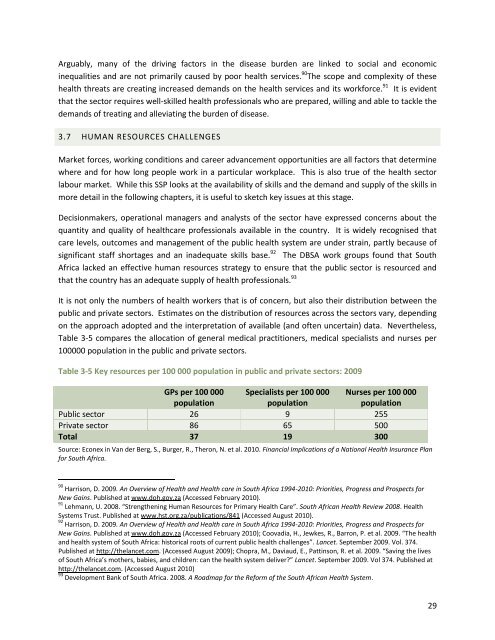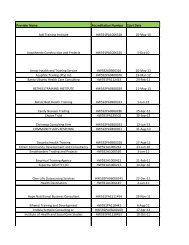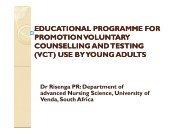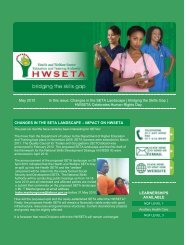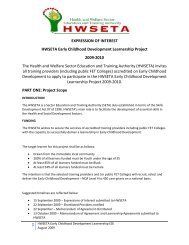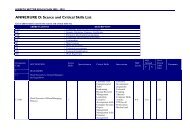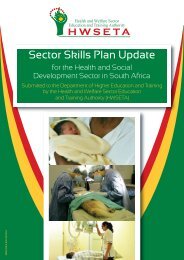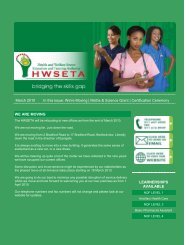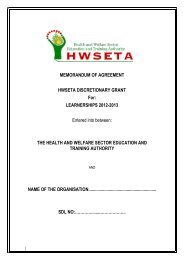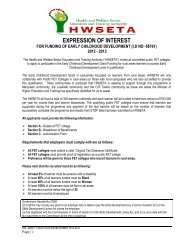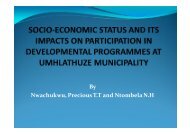sector skills plan for the health sector in south africa
sector skills plan for the health sector in south africa
sector skills plan for the health sector in south africa
Create successful ePaper yourself
Turn your PDF publications into a flip-book with our unique Google optimized e-Paper software.
Arguably, many of <strong>the</strong> driv<strong>in</strong>g factors <strong>in</strong> <strong>the</strong> disease burden are l<strong>in</strong>ked to social and economic<br />
<strong>in</strong>equalities and are not primarily caused by poor <strong>health</strong> services. 90 The scope and complexity of <strong>the</strong>se<br />
<strong>health</strong> threats are creat<strong>in</strong>g <strong>in</strong>creased demands on <strong>the</strong> <strong>health</strong> services and its work<strong>for</strong>ce. 91 It is evident<br />
that <strong>the</strong> <strong>sector</strong> requires well-skilled <strong>health</strong> professionals who are prepared, will<strong>in</strong>g and able to tackle <strong>the</strong><br />
demands of treat<strong>in</strong>g and alleviat<strong>in</strong>g <strong>the</strong> burden of disease.<br />
3.7 HUMAN RESOURCES CHALLENGES<br />
Market <strong>for</strong>ces, work<strong>in</strong>g conditions and career advancement opportunities are all factors that determ<strong>in</strong>e<br />
where and <strong>for</strong> how long people work <strong>in</strong> a particular workplace. This is also true of <strong>the</strong> <strong>health</strong> <strong>sector</strong><br />
labour market. While this SSP looks at <strong>the</strong> availability of <strong>skills</strong> and <strong>the</strong> demand and supply of <strong>the</strong> <strong>skills</strong> <strong>in</strong><br />
more detail <strong>in</strong> <strong>the</strong> follow<strong>in</strong>g chapters, it is useful to sketch key issues at this stage.<br />
Decisionmakers, operational managers and analysts of <strong>the</strong> <strong>sector</strong> have expressed concerns about <strong>the</strong><br />
quantity and quality of <strong>health</strong>care professionals available <strong>in</strong> <strong>the</strong> country. It is widely recognised that<br />
care levels, outcomes and management of <strong>the</strong> public <strong>health</strong> system are under stra<strong>in</strong>, partly because of<br />
significant staff shortages and an <strong>in</strong>adequate <strong>skills</strong> base. 92 The DBSA work groups found that South<br />
Africa lacked an effective human resources strategy to ensure that <strong>the</strong> public <strong>sector</strong> is resourced and<br />
that <strong>the</strong> country has an adequate supply of <strong>health</strong> professionals. 93<br />
It is not only <strong>the</strong> numbers of <strong>health</strong> workers that is of concern, but also <strong>the</strong>ir distribution between <strong>the</strong><br />
public and private <strong>sector</strong>s. Estimates on <strong>the</strong> distribution of resources across <strong>the</strong> <strong>sector</strong>s vary, depend<strong>in</strong>g<br />
on <strong>the</strong> approach adopted and <strong>the</strong> <strong>in</strong>terpretation of available (and often uncerta<strong>in</strong>) data. Never<strong>the</strong>less,<br />
Table 3-5 compares <strong>the</strong> allocation of general medical practitioners, medical specialists and nurses per<br />
100000 population <strong>in</strong> <strong>the</strong> public and private <strong>sector</strong>s.<br />
Table 3-5 Key resources per 100 000 population <strong>in</strong> public and private <strong>sector</strong>s: 2009<br />
GPs per 100 000<br />
population<br />
Specialists per 100 000<br />
population<br />
Nurses per 100 000<br />
population<br />
Public <strong>sector</strong> 26 9 255<br />
Private <strong>sector</strong> 86 65 500<br />
Total 37 19 300<br />
Source: Econex <strong>in</strong> Van der Berg, S., Burger, R., Theron, N. et al. 2010. F<strong>in</strong>ancial Implications of a National Health Insurance Plan<br />
<strong>for</strong> South Africa.<br />
90 Harrison, D. 2009. An Overview of Health and Health care <strong>in</strong> South Africa 1994-2010: Priorities, Progress and Prospects <strong>for</strong><br />
New Ga<strong>in</strong>s. Published at www.doh.gov.za (Accessed February 2010).<br />
91 Lehmann, U. 2008. “Streng<strong>the</strong>n<strong>in</strong>g Human Resources <strong>for</strong> Primary Health Care”. South African Health Review 2008. Health<br />
Systems Trust. Published at www.hst.org.za/publications/841 (Accessed August 2010).<br />
92 Harrison, D. 2009. An Overview of Health and Health care <strong>in</strong> South Africa 1994-2010: Priorities, Progress and Prospects <strong>for</strong><br />
New Ga<strong>in</strong>s. Published at www.doh.gov.za (Accessed February 2010); Coovadia, H., Jewkes, R., Barron, P. et al. 2009. “The <strong>health</strong><br />
and <strong>health</strong> system of South Africa: historical roots of current public <strong>health</strong> challenges”. Lancet. September 2009. Vol. 374.<br />
Published at http://<strong>the</strong>lancet.com. (Accessed August 2009); Chopra, M., Daviaud, E., Patt<strong>in</strong>son, R. et al. 2009. “Sav<strong>in</strong>g <strong>the</strong> lives<br />
of South Africa’s mo<strong>the</strong>rs, babies, and children: can <strong>the</strong> <strong>health</strong> system deliver?” Lancet. September 2009. Vol 374. Published at<br />
http://<strong>the</strong>lancet.com. (Accessed August 2010)<br />
93 Development Bank of South Africa. 2008. A Roadmap <strong>for</strong> <strong>the</strong> Re<strong>for</strong>m of <strong>the</strong> South African Health System.<br />
29


